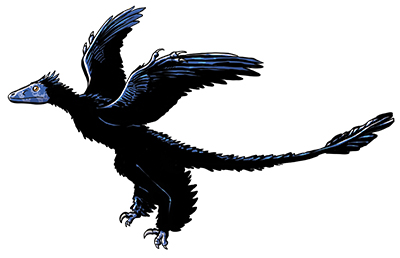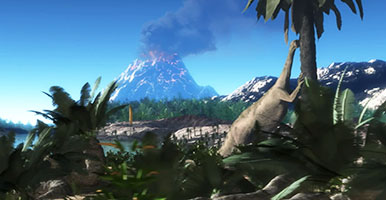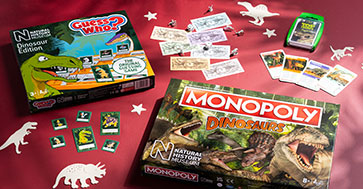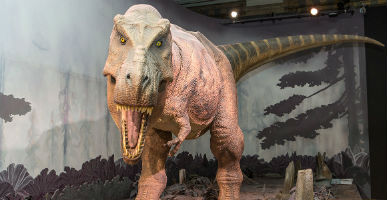Microraptor
Microraptor
- Pronunciation:
- MIKE-roe-rap-tor
- Name meaning:
- 'tiny plunderer'


- Type of dinosaur:
- small theropod
- Length:
- 0.8m
- Weight:
- 1kg
- Diet:
- carnivorous
- Teeth:
- small, sharp, pointed
- Food:
- other animals, including fish, lizards and possibly insects
- When it lived:
- Early Cretaceous, 120 million years ago
- Found in:
- China
Microraptor was a very small, feathered dinosaur with wings on its legs as well as its arms.
As a member of the dromaeosaur group, it was related to the well-known dinosaur, Velociraptor.
Of all the dromaeosaurs, we have the most fossils for Microraptor. Around 300 specimens have been found so far, indicating that this was a very common dinosaur.
Another winged dinosaur, originally named Cryptovolans, is now thought to be the same as Microraptor.
Was Microraptor the smallest dinosaur?
By dinosaur standards, Microraptor was tiny - about the size of a crow. At around 77 centimetres in length, it's often said to be 'the smallest extinct dinosaur'.
It's very hard to say which dinosaur was definitely the smallest. Anchiornis may have been smaller than Microraptor. The largest Anchiornis specimen we have is only about 62 centimetres long.
Could Microraptor fly?
When Microraptor was first studied, scientists thought it was only capable of gliding.
Later investigations showed that it could probably properly fly, like a modern bird.
Researchers have done experiments to test how Microraptor might have used its hind wings in the air. They found that, in theory, the best flying position would be to have the legs spread out sideways from the body. But we don't know if Microraptor's hips were flexible enough to do that.
Was Microraptor a pterosaur?
Pterosaurs - sometimes informally called 'pterodactyls' - were prehistoric flying reptiles. But they weren't dinosaurs.
Dinosaur skeletons have a unique type of hip joint that pterosaurs didn't have.
So, while Microraptor was probably able to fly, it wasn't a pterosaur but a flying dinosaur. It's closely related to modern birds.
The 'Archaeoraptor' hoax
One of the first known Microraptor specimens became internationally famous for an unusual reason. It was part of a notorious fossil hoax that took place in the early 2000s.
A fossil hunter in China claimed to have found an amazing specimen of a never-before-seen winged dinosaur. Well-known science magazines wrote about it and called it Archaeoraptor, meaning 'early hunter'. But then some experts grew suspicious that the specimen wasn't what it seemed.
After investigating, it turned out that the fossil was a fake. It had been made by joining together several different real dinosaur remains. The tail of Microraptor was added to the front half of another small dinosaur called Yanornis and an as-yet-unnamed third animal.
What colour was Microraptor?
In 2012, a new Microraptor fossil was discovered with preserved pigment cells. From these, researchers learned that Microraptor likely had shiny black feathers.
Some scientists originally thought that Microraptor's large eyes meant that it hunted at night. But now we know about the glossy feathers, this theory seems less likely. Out of all the modern birds with shiny coats, none are night hunters.
What did Microraptor eat?
Thanks to the large number of Microraptor specimens unearthed, we have a good idea of the types of food this dinosaur ate.
Microraptor skeletons have been found with mammal bones, bird remains and fish scales in their stomachs.
In 2019, scientists were able to study a complete, never-before-seen prehistoric lizard they found in the belly of a Microraptor. They named this new lizard Indrasaurus, after the Vedic god Indra who - according to legend - was swallowed by a dragon.
Microraptor might have scavenged its food in addition to hunting.

© Andrey Atuchin
Taxonomic details
- Taxonomy:
- Dinosauria, Saurischia, Theropoda, Dromaeosauridae
- Named by:
- Xu, Zhou and Wang (2000)
- Type species:
- zhaoianus

Step back in time
Find out more about dinosaurs' lives and the world they lived in.

Fun and games
Learn more about dinosaurs through toys, board games and activity kits, available from our online shop.

Dinosaurs gallery
Roarrr. Come face-to-face with some of the Museum's most famous dinosaurs.




